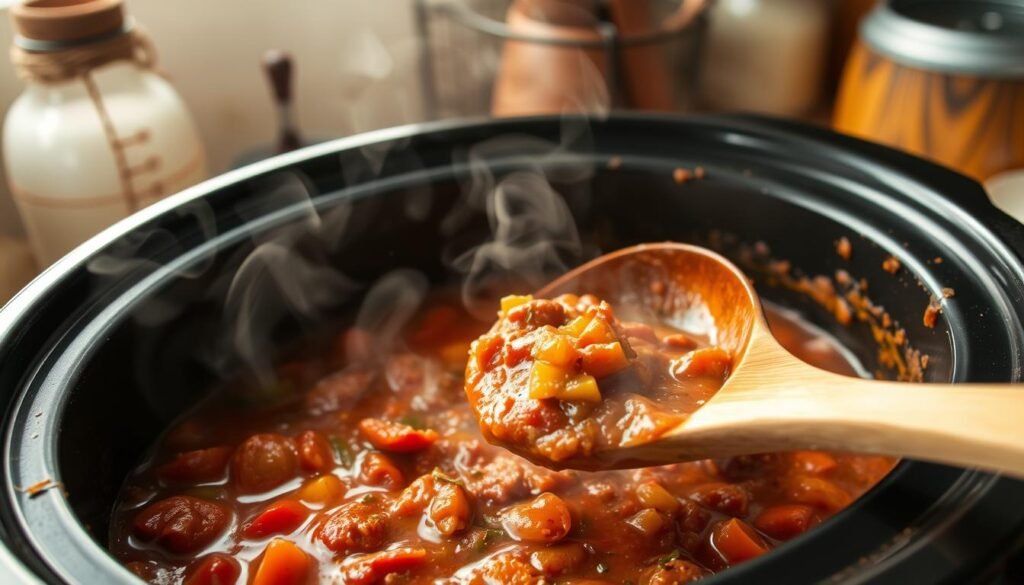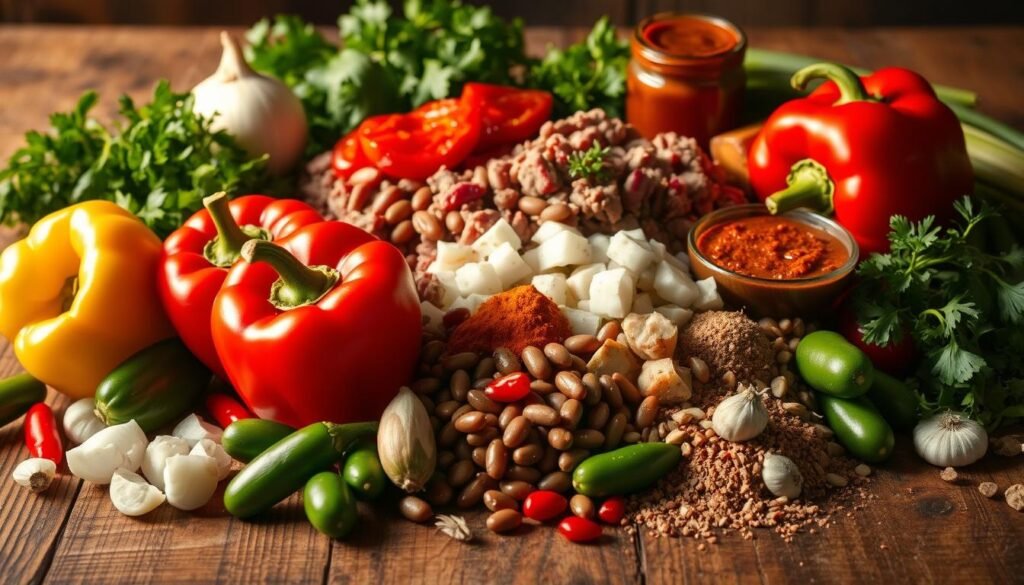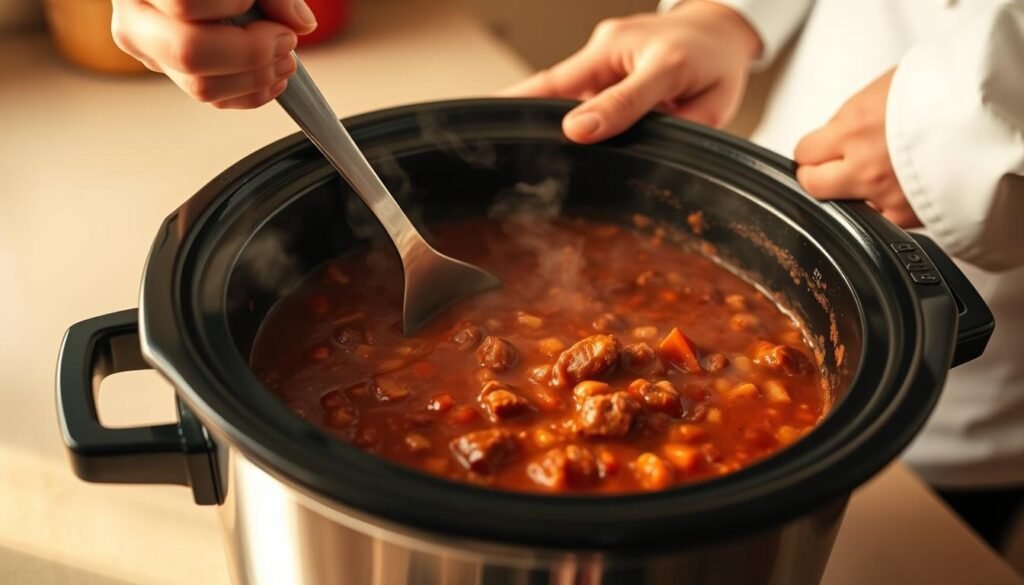
Did you know 83% of American households own a countertop appliance that effortlessly turns basic ingredients into flavor-packed meals? This hands-off cooking method unlocks textures and tastes you simply can’t rush.
Imagine coming home to tender beef that’s absorbed smoky paprika and earthy cumin for hours. Our sponsored creation (developed with support from the Beef Checkoff) combines ground meat, beans, and homemade spices in one pot. This easy chili recipe slow cooker delivers rich, comforting flavor with zero fuss—the magic happens while you work, run errands, or relax.
Families love how this approach delivers restaurant-worthy depth without babysitting the stove. Flavors intensify as tomatoes mingle with garlic and onions, creating a hearty meal that satisfies even picky eaters. Just layer your ingredients, press start, and let time work its wonders.
What makes this method stand out? Juicy results come from low-temperature simmering that keeps meat from drying out. Plus, cleanup takes minutes – no splattered pots or sticky countertops. It’s no wonder this comfort-food classic remains a weeknight hero across the U.S.
Introduction to This Hearty Slow Cooker Chili
There’s something magical about coming home to a kitchen filled with the aroma of spices and simmering ingredients. This hearty dish transforms simple staples like ground beef, beans, and tomatoes into a meal that hugs your soul. Every spoonful delivers warmth, whether you’re fueling up after a busy day or hosting friends for game night.
What makes this version special? Time becomes your ally. As ingredients mingle for hours, tomatoes soften into a velvety base while garlic and onions caramelize naturally. Beans absorb smoky paprika and earthy cumin, creating layers of taste that can’t be rushed.
You’ll love how hands-off this method feels. Just layer everything in your appliance, press start, and let heat work its charm. This easy chili recipe slow cooker yields tender meat paired with creamy beans in a rich broth that’s earned its spot as America’s favorite cold-weather comfort food.
This approach isn’t just convenient—it’s smart. Low temperatures keep proteins juicy while deepening flavors better than quick stovetop methods. Plus, cleanup stays simple since everything cooks in one pot. Perfect for weeknights or lazy Sundays when you crave satisfaction without the effort.
The Slow Cooker Advantage for Flavorful Meals
Ever wonder why award-winning dishes often need hours, not minutes? Extended heat exposure transforms basic spices into complex layers that quick methods can’t match. This approach lets ingredients bond at a molecular level, creating meals where every bite tells a story.

Why Low Heat Wins
Collagen in beef breaks down into gelatin during prolonged simmering, making meat fork-tender. Spices like cumin and smoked paprika release oils gradually, infusing broth with richness no 30-minute simmer achieves. Acidic tomatoes mellow while thickening the base naturally.
Freedom From the Kitchen
Prep takes 15 minutes – then your appliance handles the rest. Unlike stovetop versions requiring frequent stirring, this method prevents scorching. Return to a ready meal that tastes like you’ve cooked all day, even if you’ve been out running errands.
| Feature | Slow Method | Quick Method |
|---|---|---|
| Cooking Time | 6-8 hours | 45 minutes |
| Flavor Depth | Layered spices | Surface-level taste |
| Texture | Melt-in-mouth beef | Chewier meat |
| Convenience | Hands-free | Constant monitoring |
Key benefits for busy households:
- No lunchtime check-ins – perfect for 9-to-5 workers
- Energy-efficient compared to oven roasting
- Ideal for doubling batches to freeze
Key Ingredients for a Memorable Chili
Great meals start with quality building blocks. The right combination of proteins, legumes, and produce creates harmony in every bowl. Let’s explore what transforms simple components into a standout dish.

Proteins and Beans: Beef, Kidney, and Black Beans
Lean ground beef (90/10 or 93/7) delivers meaty richness without greasiness. Its savory depth forms the foundation, while dark red kidney beans add creaminess. Black beans contribute earthy notes and maintain their shape during cooking. Together, they offer varied textures and 15g of protein per serving.
Fresh Vegetables and Tomatoes
Chopped onions caramelize slowly, balancing spices with natural sweetness. Garlic cloves infuse aromatic warmth that permeates the broth. Canned diced tomatoes with their juice create a bright, chunky base, while tomato sauce thickens the mix. This duo ensures ideal acidity and body.
Rinsed beans prevent excess sodium, letting you control seasoning. A generous onion portion (1½ cups) works best. For extra richness, stir in a tablespoon of tomato paste during the final hour. These choices guarantee a balanced meal that’s as nutritious as it is satisfying.
Step-by-Step Guide to Crafting Your Chili
Building layers of flavor starts with proper technique. This method ensures every ingredient contributes to a rich, balanced dish that keeps people coming back for seconds.
Searing for Maximum Flavor
Heat a large skillet over medium-high. Add ground beef, breaking it into small pieces with a spatula. Cook 4-5 minutes until fat renders. Toss in diced onions, stirring until softened (4-5 minutes).
Add minced garlic and spices. Cook 30 seconds while stirring – this wakes up dried seasonings. Pro tip: Deglaze the pan with ¼ cup broth to capture every bit of flavor before transferring to your appliance.
Layering Ingredients Perfectly
Pour the beef mixture into a 6-quart cooker. Add rinsed beans, diced tomatoes with juice, and tomato sauce. Stir gently to combine without crushing beans.
| Step | Stovetop Method | Slow Cooker Method |
|---|---|---|
| Browning | Mandatory | Optional (enhances flavor) |
| Sautéing | Constant stirring | Hands-free after transfer |
| Simmering | 1 hour active | 6-8 hours unattended |
| Total Time | 75 minutes | 15 minutes prep |
Why this works: Browning creates caramelization that canned tomatoes can’t replicate. The appliance’s gentle heat prevents sticking while merging flavors. Set the lid and let time handle the rest!
Easy Chili Recipe Slow Cooker : Tips and Techniques
Mastering texture separates good meals from unforgettable ones. This easy chili recipe slow cooker benefits from three strategic choices that determine whether your creation boasts tender beef chunks or resembles a homogenous stew. Let’s explore methods professionals use to maintain ideal consistency.

Maintaining Juiciness and Texture
Resist the urge to stir after the first hour. Constant mixing breaks down beans and turns meat into shreds. Instead, let heat distribute evenly through the pot naturally.
| Common Mistake | Pro Technique | Result |
|---|---|---|
| Using 80/20 beef | Choose 90% lean protein | Rich flavor without grease |
| Seasoning early | Add final spices last 30 minutes | Bright, balanced taste |
| Frequent checking | Limit lid removal to twice | Steady temperature control |
Lean proteins prevent oil pools from forming on the surface. This means no last-minute skimming – just ready-to-serve goodness. Taste-test broth before serving, adjusting salt or heat levels as needed.
Timing matters too. Browning meat right before work? Set your appliance to start 2 hours later using delay settings. You’ll return to perfectly cooked ingredients that held their shape while melding flavors beautifully.
Flavor Boosters and Spice Blends
The secret to unforgettable meals lies in the dance of spices. Getting the blend right means balancing earthiness, warmth, and kick without overpowering your main ingredients. Let’s unlock techniques chefs use to create depth in every bite.

Mixing Chili Powder, Cumin, and Garlic
Start with chili powder as your foundation – its smoky base carries other flavors. Add cumin next, which adds nutty complexity. Fresh garlic brings sharpness, while garlic powder infuses mellow undertones during long cooking.
| Spice | Quantity | Role |
|---|---|---|
| Chili Powder | 2 tbsp | Base heat & color |
| Cumin | 1.5 tbsp | Earthy depth |
| Garlic Powder | 1 tbsp | Subtle aroma |
| Salt | 1 tsp | Flavor enhancer |
Combine these first before adding oregano or pepper. Stir spices into browned meat to let fats distribute flavors evenly. Wait 30 minutes before adjusting salt – ingredients release sodium as they cook.
Balancing Sweet and Spicy Notes
Counter heat with natural sweetness. A teaspoon of brown sugar or dash of cinnamon softens fiery edges. For adjustable heat, add cayenne in ¼ tsp increments during the last hour.
- Too spicy? Stir in tomato paste or honey
- Too mild? Double chili powder or add chipotle
- Flat taste? Brighten with lime juice
Remember: Fresh garlic loses bite over time, while powdered versions maintain intensity. Layer both for dynamic flavor that evolves with each spoonful.
Customizing Your Chili with Toppings
Transform your meal into a personal masterpiece with creative add-ons. A toppings bar turns dinner into an interactive experience where everyone crafts their ideal bowl. This approach lets bold flavors meet fresh contrasts while keeping meals exciting.
Cheese, Avocado, and Fresh Garnishes
Mild cheddar melts into steaming bowls, creating creamy pockets of richness. For bolder profiles, try Mexican blends with queso fresco – their salty tang cuts through smoky spices beautifully.
| Topping | Flavor Role | Pro Tip |
|---|---|---|
| Shredded Cheddar | Creamy base layer | Add immediately before serving |
| Diced Avocado | Cooling contrast | Sprinkle with lime juice to prevent browning |
| Sour Cream | Heat balancer | Use full-fat for richer texture |
| Jalapeños | Spicy crunch | Offer pickled and fresh options |
Brighten each bite with chopped cilantro or green onion. These herbs add freshness that lifts hearty ingredients. For texture variety, include crushed tortilla chips or crispy fried shallots.
Set up your spread in small bowls with spoons. Let guests layer toppings as they please – kids often love building their creations. This method accommodates dietary needs effortlessly, from dairy-free to extra-spicy preferences.
Cooking Duration: Low vs High Settings
Timing transforms good meals into legendary creations. Your appliance’s heat settings act like a conductor – low temperatures build symphonic flavors, while high heat delivers quicker harmonies. Let’s explore how both approaches craft distinct textures and tastes.
Choosing Between 6-8 Hours and 3-4 Hours
Low heat (6-8 hours) works magic on tougher cuts. Collagen breaks down into silky gelatin, creating meat that falls apart gently. Spices like cumin and oregano release oils slowly, blending seamlessly into the broth. This method suits busy mornings – set it before work and return to a ready feast.
High heat (3-4 hours) shines when time’s limited. Proteins stay firmer, while beans retain slight bite. Ideal for last-minute plans or weekends when you start prepping at noon. Flavors still meld beautifully, though with brighter, more individual notes.
| Setting | Best For | Texture | Flavor Depth |
|---|---|---|---|
| Low | Budget cuts, all-day simmer | Melt-in-mouth | Rich & unified |
| High | Quick prep, tender veggies | Heartier chew | Vibrant layers |
Pro tips for perfect timing:
- Start high for 1 hour, then switch to low – balances speed and depth
- Add delicate ingredients (like corn) during the last 45 minutes
- Stir once after 3 hours on high to prevent sticking
Whether you choose low or high, always taste before serving. A pinch of salt or squeeze of lime can elevate your creation from great to unforgettable.
Leftovers and Storage Solutions
Your culinary masterpiece deserves longevity. Smart preservation keeps flavors bold and textures inviting, whether you’re planning tomorrow’s lunch or future quick meals.
Proper Refrigeration and Freezing Tips
Cool your creation to room temperature within two hours. Transfer portions to airtight containers – glass jars prevent odor transfer, while BPA-free plastic works for freezer storage. Refrigerate for up to four days, ensuring flavors stay vibrant.
For longer storage, freeze in single-serving portions. Use silicone molds for ice cube-sized chunks perfect for soups or nacho toppings. Thaw overnight in the refrigerator or reheat directly from frozen on low heat.
Label containers with dates to track freshness. Avoid repeated reheating – warm only what you’ll eat each day. This approach maintains food safety while letting spices mature into richer profiles over time.
